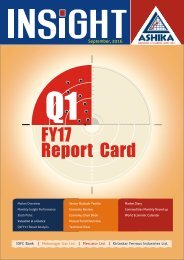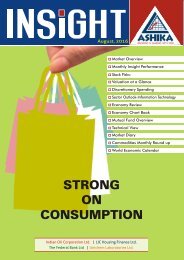You also want an ePaper? Increase the reach of your titles
YUMPU automatically turns print PDFs into web optimized ePapers that Google loves.
AUGUST <strong>2016</strong><br />
MARKET OVERVIEW<br />
Assam and Meghalaya saw extremely heavy rainfall at the<br />
beginning of the week. According to media articles, in<br />
the initial part of <strong>August</strong>, central, north-west and<br />
peninsular regions will receive normal to above-normal<br />
rainfall. The east will receive below-normal rainfall, IMD<br />
said. So far, 80% of the country’s area has received<br />
normal to excess rainfall and 20% has received deficient<br />
rains. Saurashtra and Gujarat are facing the highest<br />
rainfall deficit in the country of 57% and 43% from the<br />
long-period average, respectively. The coming week is<br />
expected to hold good news. The other major boost<br />
towards consumption is from Pay commission recently<br />
implemented by government. The share of discretionary<br />
spending over necessities has been increasing since<br />
1995. Basic spends on needs such as food and clothing<br />
is not increasing in the same proportion keeping parity<br />
with increase in income and prosperity. However,<br />
discretionary spending has been showing exceptional<br />
growth. Discretionary spending share in total household<br />
consumption during 1995 stood at 39% which grew to<br />
52% in 2005. Over the time it is expected that value<br />
would migrate from basic spends categories to<br />
discretionary spend categories and discretionary<br />
spending share would move to 70% of total household<br />
consumption by 2025. In this context, a best fitted<br />
example is need for personal transport where two<br />
wheelers now become the basic spend, whereas cars are<br />
the discretionary spend. Rise in discretionary spending<br />
should be backed by steady increase in per capita<br />
income. India’s per capita income grew at modest pace<br />
of 2.8% CAGR between FY10-FY14 and as per report of<br />
Euromonitor it is expected to grow at a CAGR of 8.6%<br />
during the period between 2015-<strong>2016</strong>. The report also<br />
stated that the Indian median income per household is<br />
set to increase by 89.8% in real terms to reach USD<br />
10,073 (in constant 2014 prices) by 2030. Such growth<br />
in income would transfer the consumer spending of<br />
Indian middle class from “bottom of the pyramid” market<br />
towards a greater and more sophisticated level. The rise<br />
in discretionary spending would be primarily driven by<br />
middle class people. A report from Credit Suisse “Global<br />
Wealth Report 2015” stated that there are 664 million<br />
adults belonging to the global middle class in 2015, or<br />
14% of the adult population, where India has 23.6 million<br />
adults who qualified as middle class in 2015, thus<br />
representing about 3% of the global middle class. India<br />
added 6.7 million adults to the middle class over these<br />
15 years, and middle-class wealth rose by USD 1.2 trillion<br />
and it accounts about 22.6% of the country’s wealth. The<br />
wealth of middle class had grown exponentially between<br />
2000 to 2007, which went up from USD 2,040 to USD<br />
5,100. Hit by global economic crisis the wealth per<br />
middle class adult plunged by 26% after which it settled<br />
at USD 5,300 in 2010. It continued to fall due to adverse<br />
exchange rates and was estimated at USD 4,352 in 2015.<br />
Government has given big bonanza to central government<br />
employees by approving 7th pay commission which<br />
according to India Ratings & Research will boost<br />
consumption in the economy by Rs 45,110 crore (0.3% of<br />
GDP) and increase savings by Rs 30,710 crore (0.2% of<br />
GDP). Incremental disposable income would lead to rise in<br />
discretionary spending which in turn would drive the<br />
demand for passenger vehicles, housing, consumer<br />
durable products, apparels, etc. Good monsoon during this<br />
fiscal is also raising hopes of improvement in farm income<br />
which remained depressed in last two years on account of<br />
scanty rainfall. A report of Goldman Sachs stated that if<br />
the rural economy grows by one percentage point, it<br />
could potentially boost overall gross domestic product<br />
(GDP) growth by up to 70 basis points over two quarters.<br />
Further, government has shown their strong commitment<br />
in spurring the rural income by increasing budgetary<br />
allocation towards agricultural & rural development during<br />
FY17 budget. Government has increased budgetary<br />
allocation to the ministry of Agriculture and Farmers<br />
welfare by ~94% YoY to ~Rs 445 billion and ~25% YoY<br />
increase in total Plan rural spending at Rs 878 billion<br />
during FY17. Such massive budgetary allocation towards<br />
2






